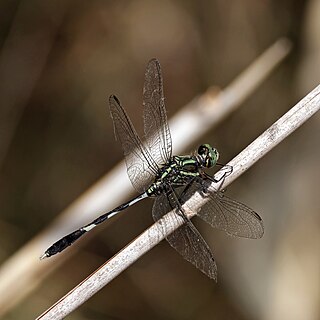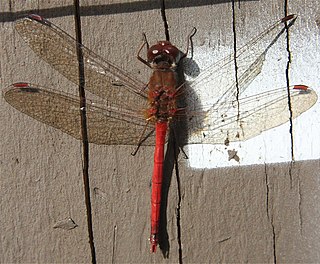
Odonata is an order of predatory flying insects that includes the dragonflies and damselflies. The two groups are distinguished with dragonflies usually being bulkier with large compound eyes together and wings spread up or out at rest, while damselflies are usually more slender with eyes placed apart and wings folded together along body at rest. Adult odonates can land, but rarely walk.

A dragonfly is a flying insect belonging to the infraorder Anisoptera below the order Odonata. About 3,000 extant species of dragonflies are known. Most are tropical, with fewer species in temperate regions. Loss of wetland habitat threatens dragonfly populations around the world. Adult dragonflies are characterized by a pair of large, multifaceted, compound eyes, two pairs of strong, transparent wings, sometimes with coloured patches, and an elongated body. Many dragonflies have brilliant iridescent or metallic colours produced by structural coloration, making them conspicuous in flight. An adult dragonfly's compound eyes have nearly 24,000 ommatidia each.

Damselflies are flying insects of the suborder Zygoptera in the order Odonata. They are similar to dragonflies but are smaller and have slimmer bodies. Most species fold the wings along the body when at rest, unlike dragonflies which hold the wings flat and away from the body. Damselflies have existed since the Jurassic, and are found on every continent except Antarctica.

The black-tailed skimmer is a dragonfly belonging to the family Libellulidae.

The skimmers or perchers and their relatives form the Libellulidae, the largest dragonfly family in the world. It is sometimes considered to contain the Corduliidae as the subfamily Corduliinae and the Macromiidae as the subfamily Macromiinae. Even if these are excluded, there remains a family of over 1000 species. With nearly worldwide distribution, these are almost certainly the most often seen of all dragonflies.

The common whitetail or long-tailed skimmer is a common dragonfly across much of North America, with a striking and unusual appearance. The male's chunky white body, combined with the brownish-black bands on its otherwise translucent wings, give it a checkered look. Females have a brown body and a different pattern of wing spots, closely resembling that of female Libellula pulchella, the twelve-spotted skimmer. Whitetail females can be distinguished by their smaller size, shorter bodies, and white zigzag abdominal stripes; the abdominal stripes of L. puchella are straight and yellow.

Libellula quadrimaculata, known in Europe as the four-spotted chaser and in North America as the four-spotted skimmer, is a dragonfly of the family Libellulidae found widely throughout Europe, Asia, and North America.

Pantala flavescens, the globe skimmer, globe wanderer or wandering glider, is a wide-ranging dragonfly of the family Libellulidae. This species and Pantala hymenaea, the "spot-winged glider", are the only members of the genus Pantala. It was first described by Johan Christian Fabricius in 1798. It is considered to be the most widespread dragonfly on the planet with good population on every continent except Antarctica although rare in Europe. Globe skimmers make an annual multigenerational journey of some 18,000 km ; to complete the migration, individual globe skimmers fly more than 6,000 km —one of the farthest known migrations of all insect species.

The Gomphidae are a family of dragonflies commonly referred to as clubtails or club-tailed dragonflies. The family contains about 90 genera and 900 species found across North and South America, Europe, Asia, Australia, and Africa. The name refers to the club-like widening of the end of the abdomen. However, this club is usually less pronounced in females and is entirely absent in some species.

The widow skimmer is one of the group of dragonflies known as king skimmers. The nymphs live in the water, molting and growing until they are ready to emerge from the water and then molting a final time to reveal their wings.

Pruinescence, or pruinosity, is a "frosted" or dusty-looking coating on top of a surface. It may also be called a pruina, from the Latin word for hoarfrost. The adjectival form is pruinose.

The blue dasher is an insect of the skimmer family. It is the only species in the genus Pachydiplax. It is very common and widely distributed through North America and into the Bahamas.

Orthetrum sabina, the slender skimmer or green marsh hawk, is a species of dragonfly in the family Libellulidae. It is widespread, being found from south-eastern Europe and North Africa to Japan and south to Australia and Micronesia.

Sympetrum vicinum, the Yellow-Legged Meadowhawk is one of some fifteen North American species of autumn meadowhawk, which are members of the Odonate family Libellulidae. It grows to 26–35 mm long.

Austrolestes colensonis, commonly known as the blue damselfly, is a species of damselfly of the family Lestidae. It is endemic to New Zealand and can commonly be found throughout the country, and at any time of the year. It is New Zealand's largest damselfly, and only blue odonate.

Diplacodes trivialis is a species of dragonfly in the family Libellulidae known as the chalky percher or ground skimmer. It is found in Seychelles, Oman, United Arab Emirates, China, Japan, India and southwards to New Guinea and Australia.

Potamarcha congener, also known as the yellow-tailed ashy skimmer, common chaser, or swampwatcher, is a species of dragonfly in the family Libellulidae. It was first described by Jules Pierre Rambur in 1842, almost fifty years before Friedrich Karsch described its genus. Potamarcha congener is one of two species making up the genus Potamarcha, together with Potamarcha puella.

Orthetrum testaceum, common names Crimson Dropwing or Orange Skimmer. is an Asian freshwater dragonfly species belonging to the family Libellulidae.

The blue corporal, also known as little corporal, is a dragonfly in the Libellulidae, or skimmer family. First described as Libellula deplanata by Jules Pierre Rambur in 1842, it is common across much of the eastern United States.

Zenithoptera fasciata, also known as the rainforest bluewing is a species of dragonfly native to much of the northern half of South America, as well as southern portions of Central America. The species has in the past been known by additional taxonomic names, including: Libellula fasciata, Libellula americana, and Libellula violacea.























